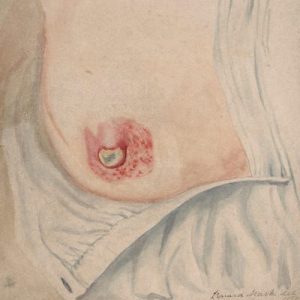Paget’s Disease of the Nipple: What It Is, Symptoms, and Treatment
The Paget’s disease of the nipple. is a rare but important form breast cancer, which appears in the nipple and areola area (the dark area around the nipple). It is a skin manifestation of an underlying cancer, which usually starts in the milk ducts and then extends towards the surface of the skin.
Often, it is the first sign of malignancy in the breast, making early recognition of symptoms critical for prognosis and survival.
What are the symptoms of Paget’s Disease?
Common symptoms include:
- Redness and irritation of the nipple and areola skin
- Dryness, peeling, or scaly texture resembling eczema
- Itching or burning sensations
- Nipple discharge
- Changes in the shape or appearance of the nipple
It is worth emphasizing that in 95% of cases, Paget's disease coexists with underlying breast cancer, either in situ or invasive carcinoma.
How common is it?
Paget's disease of the nipple affects approximately 1–5% of breast cancer cases. It is usually diagnosed in people over 50 years of age, with an average age of diagnosis of 62 years for women and 69 years for men, although in men it is extremely rare.
How is it diagnosed?
The Diagnosis of Paget's disease is based on a combination of clinical examination, imaging methods and biopsy:
- Mammography, ultrasound, or magnetic resonance imaging, to identify any underlying mass
- Skin biopsy of the nipple (punch biopsy), for histological confirmation of malignancy
The biopsy is performed under local anesthesia and provides crucial information for treatment planning.

What is the treatment for Paget’s Disease?
The primary treatment is surgical removal aiming for complete eradication of the disease. Surgery options include:
Oncoplastic Surgery (Breast-Conserving Surgery):
Used when the disease is confined to the nipple and areola, removing the affected area along with underlying tissue.
Mastectomy
The usual choice when Paget’s disease is accompanied by extensive malignancy in the rest of the breast, which is the case in most patients.
Lymph Node Assessment:
During surgery, it is performed rapid sentinel lymph node biopsy, that is, the lymph node that first receives lymph from the tumor area, to check for metastatic disease.
Breast Reconstruction:
In the case of mastectomy, many women choose inlay restoration, to improve the aesthetic result.
Additional Treatments
Depending on the biological characteristics of cancer, may be additionally administered:
- Radiotherapy (mainly after breast-conserving surgery)
- Chemotherapy
- Endocrine Therapy (for hormone receptor-positive tumors)
- Immunotherapy (in HER2-positive cancers)
Treatment decisions are made within a multidisciplinary team to tailor the approach to each patient’s needs.
In summary
Paget’s disease of the nipple is a form of breast cancer that is often underestimated due to its skin symptoms. Early diagnosis and comprehensive treatment provide a very good prognosis for most women.
Be Informed, Recognize, Act
At breastaware.gr, you’ll find reliable and scientifically validated information on all breast health topics, from prevention and early detection to treatment options. Stay informed and protect yourself and your loved ones—because knowledge saves lives.
Sources:
- American Cancer Society
- National Cancer Institute
- EUSOMA (European Society of Breast Cancer Specialists)
- WHO Classification of Tumours of the Breast
